There are as many different marketing organizational structures as there are companies – One thing we’ve learned consulting with aviation companies is that many different org structures can work either very well or very badly.
Accountability is critical to sales and marketing success. And a good marketing organizational structure, and structure of a sales department, t is critical to accountability.
Of course, it’s more important to get the “right people on the bus” than to get these people organized into the “right seats on the bus.” Good people tend to make things work, whether it’s “their job” or not. In recent years there has been much buzz about “flat” organizations and some resistance to the very idea of a hierarchy.
We all know that having a tyrant at the top is unpleasant and unproductive for everyone.
Blame the tyrant, not the structure!
That said, here are nine of the most popular organizational structures for sales, marketing and customer service teams, with pros, cons and important tips for success.
Example Org Structure #1 – The Entrepreneur
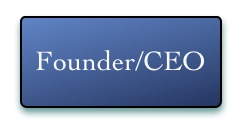
Description– Many companies start here. Some stay here by choice as a small consultancy or practice. (Insurance agents, aviation medical professionals, other consultants.)
|
Pros |
Cons |
| Low expenses. You don’t have to pay anyone. | Things tend not to get done. Sales and marketing tasks are often procrastinated, with disastrous results. |
| You have absolute authority to make on-the-spot decisions during negotiations. | There are no checks and balances to protect you from less-than-wise decisions. |
| As the company CEO/Founder, you know everything about your products & services. | You may not have the experience, skills, training or confidence to be a great salesperson. |
Success Factors:
- Recognize when you are inhibiting your company’s growth by insisting on doing everything yourself.
- Have a specific plan for when and how to grow. (i.e. “we will hire a salesperson after we have completed a pilot project with our first customer; projected for August of 2014.” or “we will engage a marketing firm when we reach XX revenues, which is projected for Q3 of 2014.)
Example Org Structure #2 – The Referral Partner

Sales & Marketing Org Structures- Entrepreneur with Referral Partners
Description – You have a formal or informal marketing program in place and have engaged customers, non-competing complementary companies (a charter company might engage a broker, for example; or a flight school might engage with a college or university) to provide a fee or other benefit in exchange for referring new customers.
Notice the dotted line – these are NOT employees. Referral partners do NOT present themselves as employees or representatives of your company.
| Pros | Cons |
| Your customers are your best salespeople! | They are not employees, so you have very limited influence over what they say and do. |
| They have direct knowledge of what it’s like to work with you. | They will only know about their own experience with your company, and may not be aware of other products or services you offer. |
| Referred clients are a better fit, have a higher trust level, and are easier to work with. | Referrals will often expect the same products/services and often prices as the customer that referred them – causing expansion beyond your current offerings to be difficult. |
| You only have expenditures (referral fees or expenses) when you have income. | Referrals come in at irregular intervals, making sales and revenue forecasts difficult at best. |
| Referrals | Some customers are prevented by law or ethical codes to accept referral fees. |
Success Factors –
- Communicate your referral program to your current customers, often.
- Make your referral process part of your sales and customer service process.
- Ask for referrals when customers are happiest – (right after realizing the greatest benefit from your product or service.)
- Be generous with referral fees or bonuses.
- If your customer can’t accept referral fees, send a gift (such as a fruit basket) that is within the guidelines they set. Another idea is to make a donation toward a cause that you both support. (We like the Rotary Foundation and the Special Operations Warrior Foundation.)
Example Org Structure #3 – Add a Sales Rep
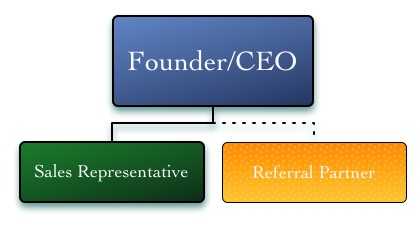
Sales & Marketing Org Structures- Sales Team
Description – You hire a dedicated salesperson. In this simplest structure of a sales department, you hire is a person that IS an employee or contractor that presents himself or herself as a representative of your company. We recommend this in addition to, not instead of, any referral programs you have started.
| Pros | Cons |
| Someone needs to devote adequate time to researching and following up with each prospect – an absolutely vital task! | A salesperson will never have the same credibility as the founder/CEO, some customers will still demand some of the time/attention of the Founder/CEO. (Experience has shown us that the Founder/CEO, as the public “face” of the company, will never be completely relieved of primary responsibility for sales and marketing!) |
| Since this person is on the payroll, you have the right and obligation to expect they will log interactions in your CRM (customer relationship management) system, and lend their expertise and experience they learn from talking with customers to improve marketing materials and processes. | You have to remember this person needs to spend most of his or her time with customers. Any bureaucracy they are required to participate in is time taken away from time spent with customers. |
| You have an extra “pair of hands” to send to various events. | You cannot change the specifications or prices without ensuring that sales people are “in the loop.” |
| You must spend the time outlining and communicating expectations, and developing an accountability system. | If you don’t provide appropriate tools and accountability process, miscommunications will happen. |
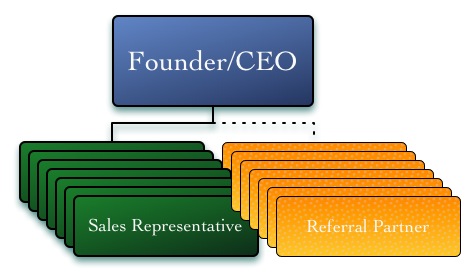
Sales & Marketing Org Structures- Sales Team Expanded
This organization is scalable in several ways.
Success Factors –
- You can (and should) use commission as part of this person’s compensation package.
- You can (and should) also pay this person a salary, since you need to place certain demands on his time and require that he or she do things “your way.” Commission-only agreements with dedicated salespeople are a mistake. It takes them time to come up to speed on your products and services, and you will need to make certain demands on their time (product training, coordination with marketing, etc.) that may not directly result in sales and subsequent commissions.
Example Org Structure #4 – Regional Sales Managers

Description – When you add more salespeople, a larger structure of a sales department, you have the challenge of determining who should be managing which prospects and who gets “credit” for which sales. Organizing by region is a very traditional way of organizing a sales team, where each has a “territory” divided along geographical lines.
These Regional Sales Managers (or whatever title you give them) may report to a Sales Lead or directly to the Founder/CEO or company leadership.
| Pros | Cons |
| This model has been used successfully by very large companies for many years and has the advantage of tradition. | It does not accommodate for every situation and can be taken too literally, leading some prospects and opportunities to be ignored or “fall through the cracks.” |
| This is pretty simple – responsibility for any given prospect is usually very clear, based on where that prospect is located. | Each salesperson has different strengths and weaknesses. A company may have a prospect who’s personality or situation would be better served by a different salesperson. |
| Responsibility and accountability are fairly easy. Looking at a report of sales numbers makes it obvious who is being the most productive. | Some areas will have more and better opportunities than others. |
| Salespeople get to spend less time (and money!) traveling. | |
| Salespeople get to know the area and the prospects in it really well. |
Success Factors –
- It may be necessary (and contentious) to “redraw boundaries” from time to time as markets change.
- It is a good idea to have a process where salespeople can work together and share a commission if one has a more appropriate background, opportunity or circumstance to assist a prospect outside of his “territory.”
- It’s important to ensure territorial salespeople get isolated or “out of touch” with developments in the company. Technology can help with this. We use Basecamp for project management and file sharing, Infusionsoft as a CRM (customer relationship management) and GoToMeeting for video conferencing.
Example Org Structure #5 – Salespeople who are Product Specialists
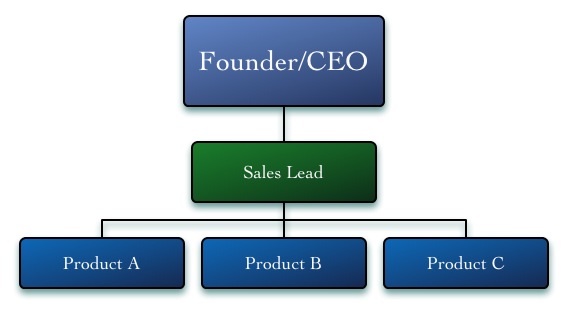
Description – Organizing your sales team by product allows salespeople to become “specialists” on a particular product or product line.
These Product Specialists (or whatever title you give them) may report to a Sales Lead or directly to the Founder/CEO or company leadership.
| Pros | Cons |
| Each salesperson has the opportunity to gain experience and become “expert” on a particular product. This is particularly good for very technical or complex products. | “When you’re holding a hammer, everything looks like a nail.” Your “Product A” expert may not recognize (or have an incentive) to let a prospect know that “Product B” may be a better fit for the circumstance. |
| Product specialists will get to know the types of companies that their product fits best. A deeper knowledge of their needs, problems and concerns will help them sell more effectively. | Product Specialists may need to travel more than a more generalized salesperson who is assigned to a particular “territory.” |
Success Factors –
- As with territorial salespeople, it may be necessary (and contentious) to “redraw boundaries” from time to time as products (or services) evolve.
- It is a good idea to have a process where salespeople can refer a customer to each other when a a salesperson recognizes a situation that is a better fit for a different product.
Example Org Structure #6 – A Marketing Department
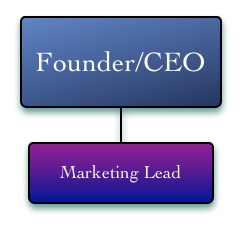
Description – As a Founder/CEO, you probably have many opportunities to buy an ad, commission a website, or attend a trade show. But you probably don’t have time to research all of these opportunities, pick the best ones, execute them properly, and measure the results.
You may decide that you need an employee to manage all of your marketing efforts (and avoid “Random Acts of Marketing!”)
| Pros | Cons |
| A dedicated marketing professional can devote more time to coordinating marketing efforts | It’s rare that a single individual will be have sufficient expertise in trade shows, print ads, direct mail, web sites, social media and all of the other opportunities for marketing. Your Marketing Lead will be inclined to “lead with his strength” and recommend whichever channel he or she is most experienced and skilled with, regardless of which is the best for your current situation. |
| A dedicated marketing professional can focus on marketing year-round and create a more complete marketing calendar and plan, making events like trade shows smoother and less reactive. | You have the expense of another employee year-round. |
A dedicated marketing team can scale up to fit your needs.
Success Factors –
- Dedicated employees require a lot of overhead.
- Our advice – “hire slowly.” Determine which channels and expertise are really needed on an ongoing basis and worth the expense of dedicated personnel.
Example Org Structure #7 – Sales, Marketing and Customer Service Teams
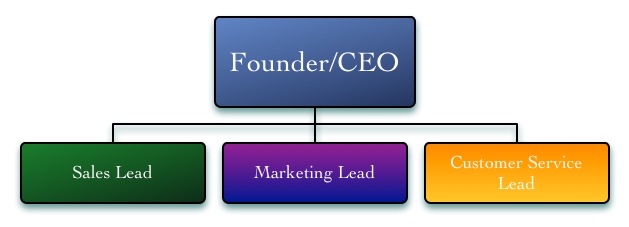
Description – With all of the new customers coming in, you need to provide excellent product or service delivery and customer service. This is key to KEEPING more sales coming in!
We believe that customer service needs to be on equal footing with sales and marketing. If your Sales Lead and Marketing Lead report directly to the Founder/CEO, so should your Customer Service Lead.
| Pros | Cons |
| A Customer Service Lead can spend time devoted to ensuring that each new customer has a great experience. | Another dedicated employee requires additional overhead. |
| This person should work closely with Sales and Marketing to ensure that the customers’ unique needs are understood, and helps develop marketing materials and processes such as referral programs that really suit your customers. | Adding another person adds complexity to each decision. The Customer Service person should be included in product specification and pricing decisions, as well as providing information to upgrade products and design new offerings. |
All of these teams (sales, marketing and customer service) can be scaled to suit your needs.
- Success Factors –
- In many organizations, we see Customer Service as a subservient function to Sales and Marketing, or have it separated by a large gap.
- We’ve found that elevating Customer Service to the same level as Sales and Marketing puts the same emphasis on existing customers as on getting new ones.
- Referrals are the most cost-effective method of sales, but they absolutely depend on giving your current customers a first-class experience.
Example Org Structure #8 – Adding a Customer Experience Manager
Description – If the Founder/CEO (or company leader, whatever we call you) becomes too busy to manage all three teams, we recommend keeping all three on the same footing by adding a Customer Experience Manager who coordinates the activities of all three teams.
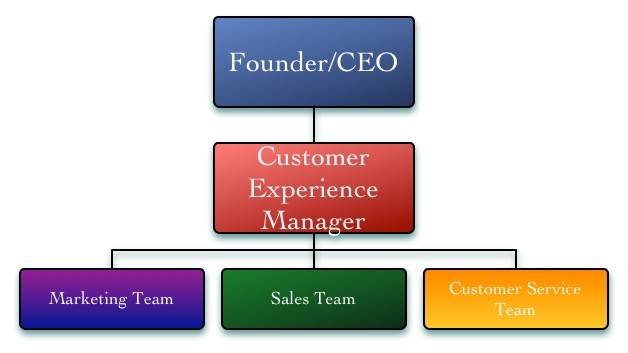
| Pros | Cons |
| This frees the CEO/Founder from day-to-day coordination of the three teams. | The Founder/CEO doesn’t have as much control over the details of sales, marketing and customer service as he may want. |
All of these teams (sales, marketing and customer service) can be scaled to suit your needs.
- Success Factors –
- There has to be a clear process to escalate appropriate items to the CEO/Founder.
- This position requires a lot of trust, because the Customer Experience Manager has responsibility for the reputation of the company with past, present and future customers!
More Examples -Outsourcing to ABCI
Description – In many cases, outsourcing marketing (and some Sales and Customer Service tasks) to ABCI makes a lot of sense.
These are some examples of how ABCI has worked successfully with companies of different sizes.
ABCI Reporting Directly to Founder/CEO

In this case, we realize that we need to cover the basics of marketing, sales and customer service between us.
In this situation, we would develop an agreement that works for the time and skills of the individual client, which usually means:
- ABCI performs and/or automates most marketing tasks.
- ABCI provides assistance with some sales tasks (identifying most probably prospects, outlining suggested next steps, etc.)
- ABCI provides some automation of customer service tasks, such as a Tip of the Week email, a New Customer welcome package with literature and how-to-videos, etc.
- The CEO/Founder is responsible for making sales calls.
- The CEO/Founder is responsible for providing hands-on product delivery and customer service.

This variation is one of the first improvements we make as your company grows – to establish and manage a referral process.

In this variation, we work with your new or existing sales team. ABCI manages the marketing system, which generates leads for the sales team. We also provide sales orchestration service, such as mystery calls, accountability reporting, outlines and checklists.
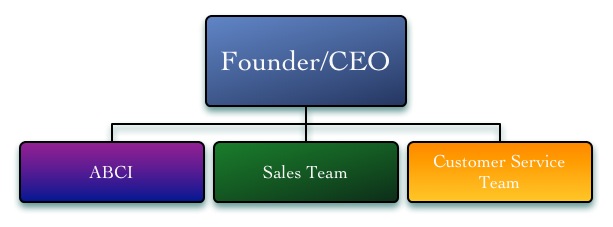
In this variation, we work with your new or existing sales team AND your Customer Service team to ensure all customer-facing materials and interactions are coordinated. ABCI manages the marketing system, which generates leads for the sales team, and materials and automated functions for the Customer Service Team as well.
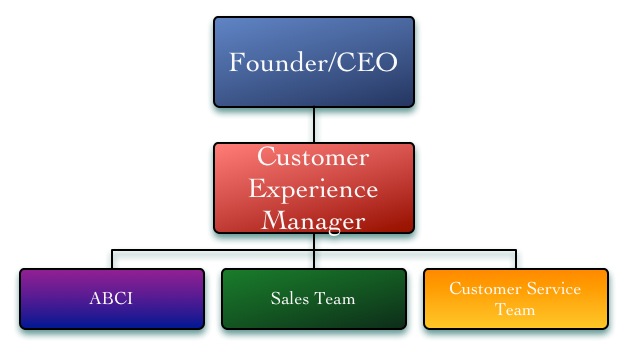
In this variation, ABCI reports to the person responsible for the total customer experience. This positions us to provide all of the benefits of a marketing system, sales support, and customer service automation.
Some companies already have the perfect sales, marketing and customer service team in place.
We can improve performance by providing real-world examples and timely coaching on key topics for sales and marketing professionals in the aviation industry. Why reinvent the wheel when you can learn from other companies about what’s worked, what hasn’t, and what’s changing in the aviation market?}.

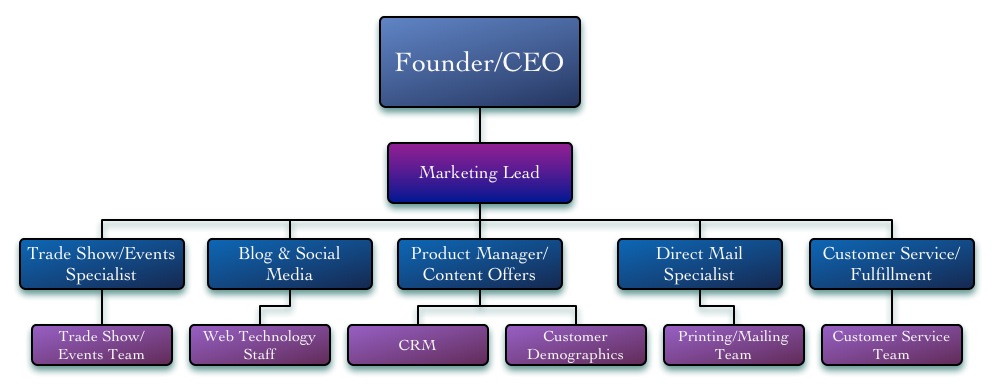
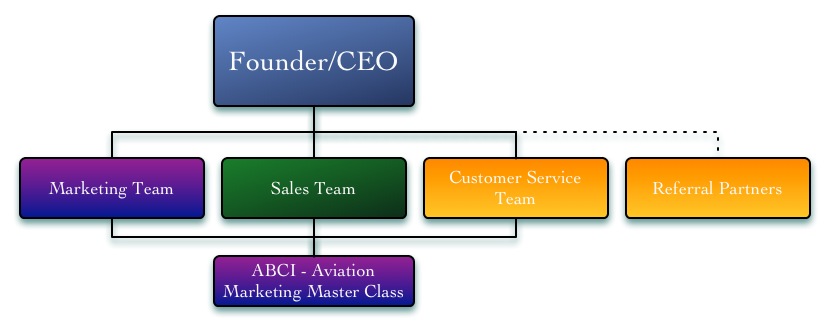





Well done!
Thanks Vince!
Interesting that I’ve been having a similar conversation with about three different people – “How will ABCI fit with my current team?” The answer- “however it works best to achieve the objectives you set!”